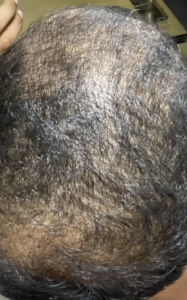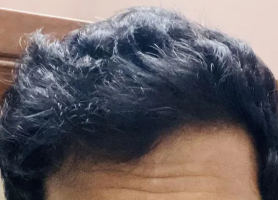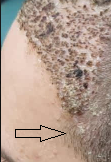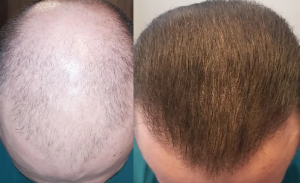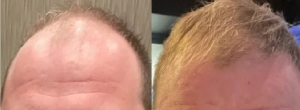I somehow misplaced the photo. It shows a man who went to an illegal clinic in Turkey and someone created a female hairline for him. The arrow would have pointed to the temple peak which is largely covered with the hair transplant making his hairline presentation the perfect female hairline. Sorry for the absence of the photo, but my point is that you should make sure that whoever is doing your transplant knows what they are doing. Unfortunately, taking out these female pattern hair grafts is going to be expensive. If he keeps it, everyone will know that something is wrong with his look.
A good photo to show your recession should be a frontal view with your hair pulled back and your eyebrows lifted high so that the creases on the forehead show up. This will show the anatomical landmarks to measure where your hairline belongs and more about what the shape should be. A normal hairline is one finger breadth above the highest crease of the furrowed brow. Anything higher is recession. I can only guess that this man doesn’t have recession because the frontal hairline is flat, which is an evolutionary step towards a mature hairline, but if he supplied me the photos as I outlined above, I could be more definitive.
When untrained people do hair transplant surgery, besides risking the lives of the patients, the things that are simple for me, a skilled hair transplant surgeon, is not understood by people who haven’t been trained in the field. From my intelligence in the field, Turkey has hundreds of clinics staffed without a skilled surgeon doing the surgery. Some clinics have a doctor who ‘fronts’ for the marketing operation but doesn’t know anything about doing a hair transplant. Here is a picture of an unfortunate young man who saw a bargain and purchased a hair transplant in Turkey. What he got it, was a female hairline that goes down to the temple peaks on the side. I doubt that he wanted to have the hairline of a woman, but now he will have other problems once it grows.. The arrow points to where the temple peaks (now buried in the rounded female hairline) should be prominent.
The cowlick is a remnant from your juvenile hairline and many women think it is sexy. Consider yourself sexy and lucky
“I don’t know of any data that shows finasteride deleterious for men wangling to conceive but I do tell my patients that if they know they are actively trying to conceive then it is prudent to go to topical. Although hundreds of thousands of men have probably conceived while on finasteride without any know association at the same time no one is going to study to issue to see if we get birth defects by taking medications purposefully while trying to conceive. It just depends on how conservative you wish to be.”
Ryan Welter, M.D., PhD
I AGREE WITH DR. WELTER
I’ve been browsing your blog for weeks now trying to find an answer My hair loss progressed after taking two medications 4-5 months ago (sertraline and abilify) I also had some severe side effects due to these medication my hair line was changing prior to starting these meds but i feel like it has accelerated since the then
Many medications have hair loss as a known side effect, however, if you were thinning prior to taking these medications, it is highly likely that what you are now experiencing is the result of genetic balding. Contact a good doctor in your area to get confirmation of this.
Is finasteride 3 times a week enough to strengthen my hair ?
Finasteride is not like a product that when you add it, you see immediate results. If it thickens the hair, it only does it because it is reversing miniaturization and therefore will not impact hairs that are not miniaturized. Finasteride does one of three things well: (1) stops hair loss, (2) slows hair loss and (3) reverses hair loss. For these benefits you must continue using it or the benefits go away. The recommended dose is 1mg but for those who want to use less, a half dose is 80% as effective and a 1.4 dose is 50% as effective.
Doc, it is known that stopping minox will cause minox-grown hairs to fall out. Therefore, minox is a “for life” drug. Is it the same story for topical rosemary oil? Also, do you know if rosemary works by dht inhibition like finasteride or by increasing circulation like minox?
I don’t know how Rosemay Oil works, but I suspect it is a DHT blocker. All of these drugs must be maintained to keep the benefits. The only way to not depend on any treatment is to get a Good Hair Transplant. Minoxidil may increase circulation but that is not how it works to grow new hair
I did not realize not taking it for 2.5 months would cause my hair fall to go into overdrive. If I continue again for the next 2 yrs will I regain what has fallen in the last 2.5 months?
There will be positive results from going back on finasteride; however, it may not go back to where it was before you stopped it.
I’ve been on 1mg fin a day for a couple weeks now. I read other opinions saying it’s best to wait about six months so you can more accurately assess whether fin is working. But most people on here seem to start minox and fin at the same time.
These two drugs have different mechanism of action so taking both at the same time increases your odds of getter hair growth, especially if you are younger than 25.
Fully bald father and a son with a full head of thick hair? What do you think Dr. Rassman?
Inheritance from the mother’s side of the family is likely here. He could have inherited his father’s maternal hair as well.
It would be interesting to read some studies about baldness in identical twins, since they share the same dna, in order to asses to what extent the previous statement is true.
I have had many identical twins come in to see me, some for hair transplants. I have written about them and generally my writings might satisfy your curiosity. You can find them here: https://baldingblog.com/?s=identical+twins
Page 63 of 1239

